Every day, you use your phone to check messages, scroll through social media, or find your way around. That phone runs Android, the powerful operating system used by billions of people worldwide.
In 2025, Android is more popular than ever. Developers create apps, businesses reach customers, and users enjoy smooth experiences. Whether you’re a curious user adjusting settings or a marketer trying to reach the right audience, this guide gives you all the information you need.
We’ll cover key statistics on Android’s market share, growth trends, and insights from online communities like Quora and Reddit. You’ll also find tips to make the most of Android—whether it’s for personal productivity, picking the best apps, or boosting your business.
Since its launch in 2008, Android has grown rapidly. Developers love its open-source nature, allowing them to customize everything from budget phones to high-end models. Users appreciate the variety of affordable options and a huge selection of apps.
For businesses, Android’s 3.6 to 4.2 billion active users offer a powerful audience for targeted marketing. This guide includes detailed stats, easy-to-read tables, and practical advice based on both past data and 2025 projections.
Ready to learn how Android shapes the digital world? Let’s get started!
Android’s Global Dominance: How Many Users Power This Giant?
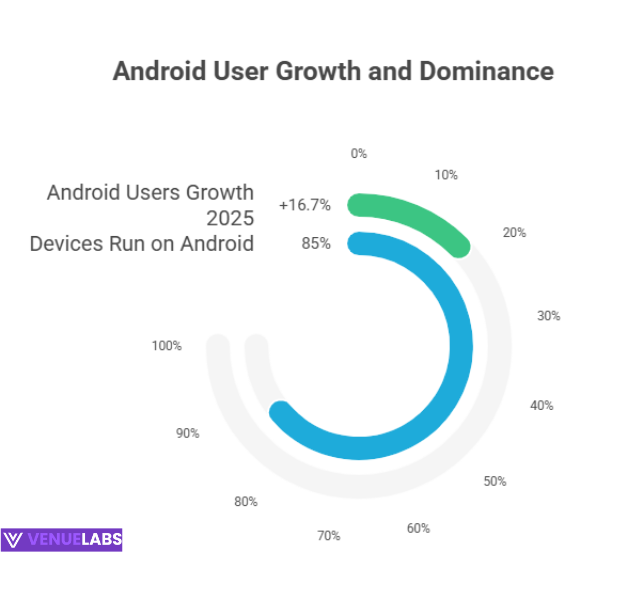
Android users number over 3.6 billion worldwide in 2025, according to core reports, but projections push that to 4.2 billion by year’s end. You see this growth in everyday life—friends in India swear by Xiaomi devices, while Brazilians flock to Samsung for reliable performance.
Google develops Android as an open-source platform, which means manufacturers like Samsung, Xiaomi, and Oppo tweak it freely. This flexibility drives affordability; Android phones average $261 in selling price, far below iOS rivals. You benefit by accessing high-quality tech without breaking the bank.
Why does Android thrive? It reaches emerging markets where over 85% of devices run on it, like India, Brazil, Indonesia, Vietnam, and Turkey. In these regions, users demand budget-friendly options with strong battery life and camera features.
For you, this means Android apps optimize for diverse hardware, ensuring smooth performance on your device. Developers use these stats to prioritize features that appeal to global audiences, such as multilingual support or offline modes.
Look at the growth trajectory. Android hits 500 million users in 2012, just a year after its full rollout. By 2014, it crossed 1 billion, becoming the top mobile OS. Fast-forward to 2025, and annual shipments top 1.3 billion units.
You can use this for your benefit: If you run a small business, target Android-heavy regions with localized ads on Google Play.
Users on Reddit often ask about this in threads like “Android’s role in emerging markets 2025,” where commenters highlight how 5G adoption in Asia boosts streaming apps.
Here’s a table that tracks Android users year by year, blending historical data with 2025 estimates from regression analysis:
| Year | Number of Android Users (in Billions) |
| 2012 | 0.5 |
| 2013 | 0.7 |
| 2014 | 1.0 |
| 2015 | 1.4 |
| 2016 | 1.7 |
| 2017 | 2.0 |
| 2018 | 2.3 |
| 2019 | 2.5 |
| 2020 | 2.8 |
| 2021 | 3.0 |
| 2022 | 3.3 |
| 2023 | 3.5 |
| 2024 | 3.6 |
| 2025 | 4.2 (Estimate) |
Source: Business of Apps
This table shows a steady 8.3% growth rate from 2023 to 2025. You notice the acceleration post-2020, fueled by pandemic-driven digital shifts.
On Quora, users query “Android user growth 2025 predictions,” and answers point to AI integrations like Gemini boosting adoption. For your benefit, track your own usage via Android’s built-in Digital Wellbeing tool—it mirrors these global trends and helps you manage screen time.
- Also read about: iPhone Users Statistics
Android OS Market Share: Why 73.9% Means Opportunity for You
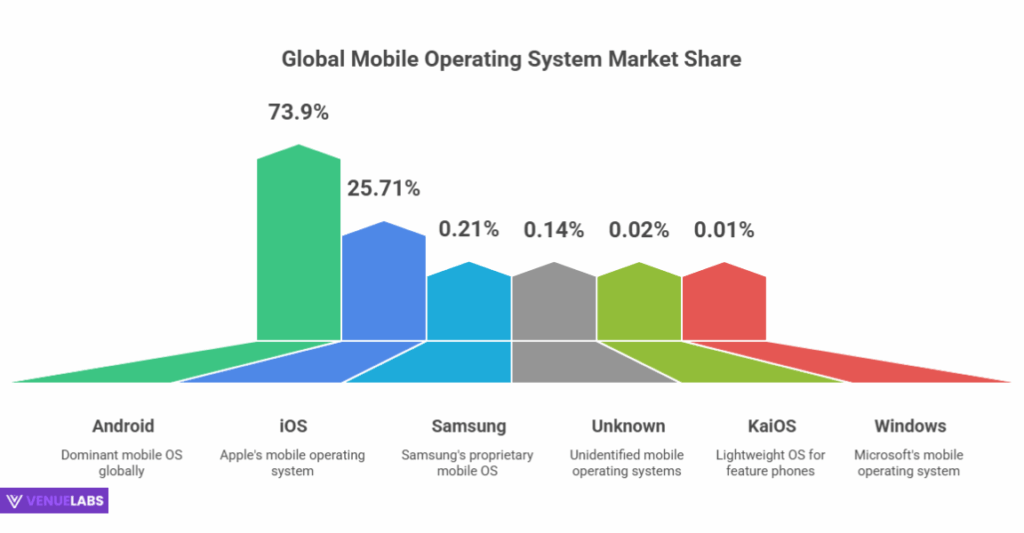
Android commands 73.9% of the global mobile OS market in 2025. You feel this dominance when you download apps faster on Google Play or switch devices without hassle.
iOS trails at 25.71%, with niche players like KaiOS at 0.02%. Why? Android’s openness lets OEMs (original equipment manufacturers) innovate freely. Samsung ships 258 million units yearly, while Xiaomi targets budget segments. In the US, Android holds 42.51%, but globally, it crushes in volume.
Compare this to iOS: Android ships more units but earns less per device due to varied pricing. You benefit as a user with choices—from $100 entry-level phones to $2000 flagships.
Marketers love it; 70% market share means broader reach. Recent web data confirms Android at 72.72% early 2025, with slight dips in premium markets like the US (where iOS hits 58%).
Reddit threads on r/Android discuss “2025 market share shifts,” with users noting Android’s edge in 5G and foldables. One popular post asks, “Will Android hit 80% by 2026?” Commenters cite emerging market growth as key.
Quora echoes this: “Android vs iOS 2025 stats?” answers emphasize Android’s 48.2% of global population (3.9 billion users out of 8.088 billion).
Here’s a snapshot of global OS shares:
| Operating System | Percentage of Mobile Devices (2025) |
| Android | 73.9% |
| iOS | 25.71% |
| Samsung (Custom) | 0.21% |
| Unknown | 0.14% |
| KaiOS | 0.02% |
| Windows | 0.01% |
You use this table to decide: If you develop apps, focus on Android for scale. Users on forums ask about “hidden Android stats,” like how 83.32% of 2021 devices ran Android— a trend holding strong.
- Also read about: 10 Best Android Survey Apps
Android vs iOS: Head-to-Head Worldwide and in the US
Android edges iOS globally with 73.9% vs 25.71% in 2025. You see this in app downloads: Google Play logs billions more than the App Store.
Worldwide, Android thrives in Asia and Latin America, where affordability wins. iOS dominates premium segments, but Android’s volume creates ecosystems for you—think vast accessory markets.
In the US, iOS leads at 57.24%, with Android at 42.51%. Why? Cultural preferences for Apple’s ecosystem. But Android grows among younger users (18-24: 70% adoption). You benefit by choosing Android for customization; Reddit users in r/AndroidQuestions rave about modding ROMs for better battery.
Worldwide Android vs iOS Market Share:
| Year | Android | iOS |
| 2017 | 72.63% | 19.65% |
| 2018 | 75.45% | 20.47% |
| 2019 | 75.47% | 22.71% |
| 2020 | 73.06% | 26.28% |
| 2021 | 71.89% | 27.34% |
| 2022 | 71.47% | 27.85% |
| 2023 | 70.26% | 29.02% |
| 2024 | 71.85% | 27.6% |
| 2025 | 73.9% | 25.71% |
Source: Statista
US Android vs iOS Market Share:
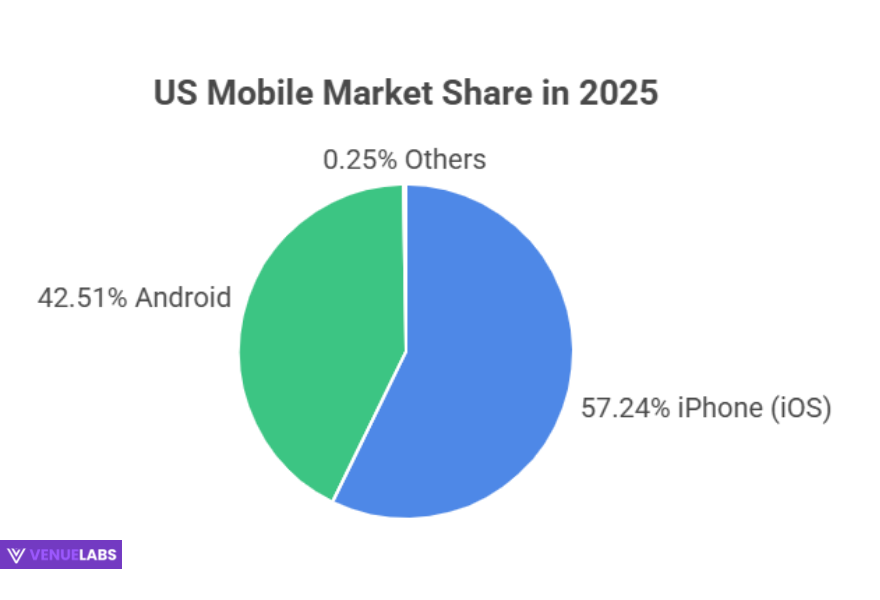
| Year | Android | iOS |
| 2016 | 45.2% | 53.19% |
| 2017 | 45.23% | 53.89% |
| 2018 | 44.73% | 54.82% |
| 2019 | 44.51% | 55.23% |
| 2020 | 40.27% | 59.54% |
| 2021 | 41.11% | 58.58% |
| 2022 | 42.94% | 56.74% |
| 2023 | 41.46% | 58.1% |
| 2024 | 42.34% | 57.39% |
| 2025 | 42.51% | 57.24% |
These tables highlight Android’s resilience. On Quora, “More Android or iPhone users 2025?” debates reveal Android’s 48.22% global population share vs iOS’s 18.05%.
US users hit 149.64 million for Android, up 5.63 million from 2023. You apply this: Switch to Android if you travel internationally for better app compatibility.
Vendor Wars: Samsung Leads, But Xiaomi Challenges
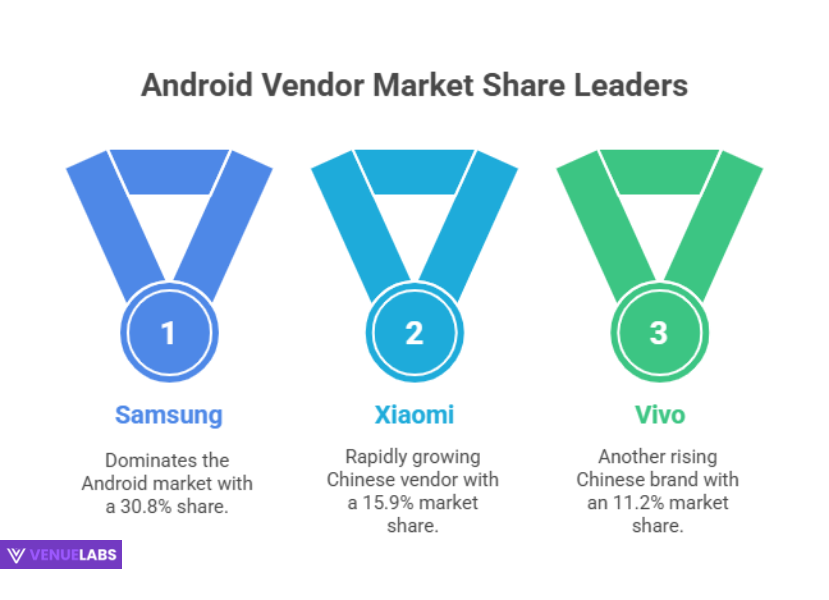
Samsung grabs 30.8% of the Android vendor market in 2025. You know their Galaxy series for stunning displays and long updates. Xiaomi follows at 15.9%, offering value-packed devices.
Vivo (11.2%) and Oppo (10.1%) shine in Asia. This diversity benefits you—pick Motorola for clean stock Android or Honor for AI features.
In China, Huawei’s AppGallery leads at 44.31% due to Google bans, but globally, Samsung ships 58 million units quarterly. Reddit’s r/androiddev threads on “2025 vendor stats” note Infinix’s rise in Africa (3.2% share). Quora users ask “Top Android brands 2025?” and praise Tecno for budget 5G.
Vendor breakdown:
| Company | Market Share |
| Samsung | 30.8% |
| Xiaomi | 15.9% |
| Vivo | 11.2% |
| Oppo | 10.1% |
| Realme | 5.2% |
| Honor | 3.3% |
| Infinix | 3.2% |
| Amazon | 3.1% |
| Huawei | 2.8% |
| Tecno | 2.7% |
| Motorola | 2.3% |
| Others | 9.4% |
You use this to choose: Samsung for reliability, Xiaomi for specs-per-dollar. Forums buzz about Amazon’s Fire tablets gaining traction.
App Ecosystem Boom: 2.06 Million Apps and Counting
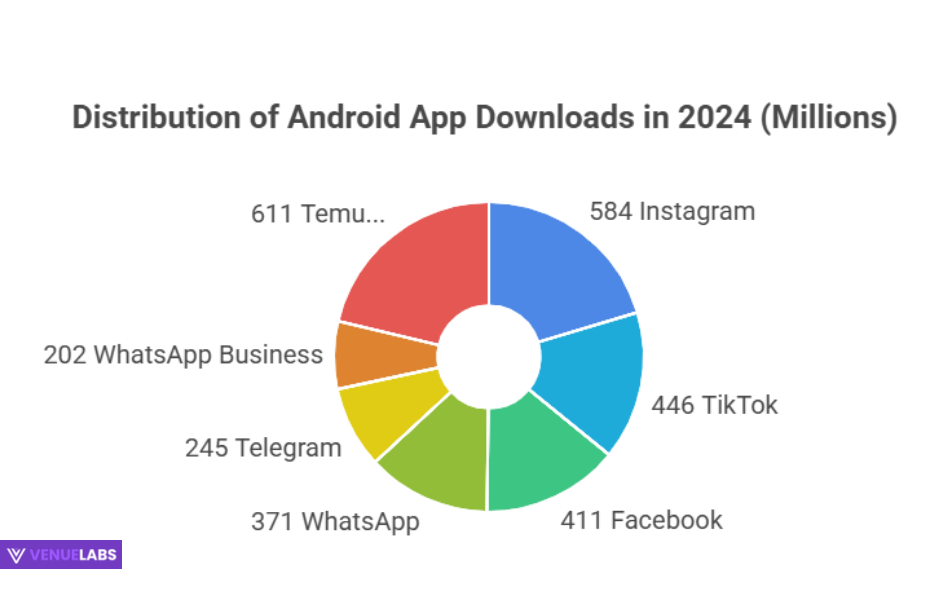
Google Play hosts 2.06 million apps in Q2 2025. You download Instagram (584 million times) or TikTok (446 million) effortlessly.
Apps grow from 1.68 million in 2024, with gaming at 21% of downloads. Users spend 3 hours 42 minutes daily on Android, less than iOS’s 4 hours 54 minutes, but install twice as many apps.
Why? Android’s openness fosters innovation. Developers earn $65 billion in 2025 consumer spending, up from prior years. Social media tops downloads; WhatsApp hits 371 million. On Reddit’s r/androidapps, users seek “2025 app stats trackers,” recommending Digital Wellbeing for personal insights.
App growth table:
| Quarter/Year | Number of Apps on Google Play |
| Q1 2022 | 2,591,578 |
| Q2 2022 | 2,654,747 |
| Q3 2022 | 2,683,925 |
| Q4 2022 | 2,694,114 |
| Q1 2023 | 2,673,292 |
| Q2 2023 | 2,597,819 |
| Q3 2023 | 2,593,870 |
| Q4 2023 | 2,438,553 |
| Q1 2024 | 2,000,247 |
| Q2 2024 | 1,682,635 |
| Q2 2025 | 2,066,588 |
Top downloads:
| Application | Number of Downloads (Millions) |
| 584 | |
| TikTok | 446 |
| 411 | |
| 371 | |
| Telegram | 245 |
| WhatsApp Business | 202 |
| Temu | 191 |
| Snapchat | 154 |
| Threads | 136 |
| CapCut | 130 |
You benefit: Curate your home screen with these for productivity. Quora’s “Most downloaded Android apps 2025” highlights CapCut’s editing surge.
User Demographics: Who Uses Android and Why It Matters to You
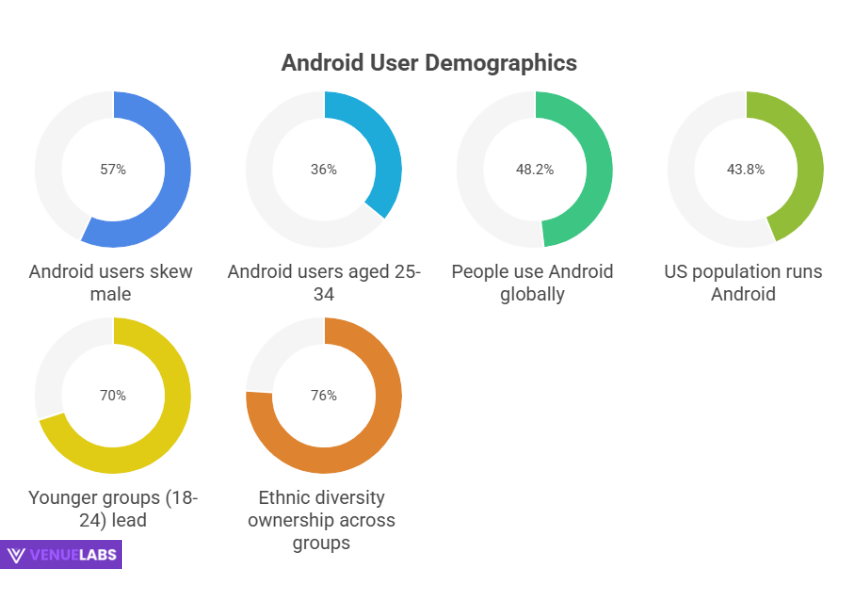
Android users skew male (57%), with 36% aged 25-34. You fit if you’re in that bracket, enjoying gaming apps that generate $37.3 billion yearly. iOS users (51% female) spend more ($21.2 billion vs Android’s $10.4 billion), but Android wins in volume. Globally, 48.2% of people use Android.
In the US, 43.8% of the population (149.64 million) runs Android. Younger groups (18-24: 70%) lead. Reddit’s r/Android debates “Demographics 2025,” noting ethnic diversity: 75-77% ownership across groups. Quora asks “Android vs iOS users by age?”—answers show Android’s appeal to budget-conscious millennials.
You apply this: Tailor social habits. Android users game more; try Subway Surfers (304 million downloads).
Latest Buzz from Quora and Reddit: Fresh 2025 Insights
Users on Quora and Reddit crave real-time Android usage stats. On Quora, “Where do you see Android in 2025?” sparks talks on flexibility—users switch back from iOS for customization. One answer: “Android won’t die; its 70% share grows with AI.” Reddit’s r/Android updates version starts with October 2023 data, but 2025 threads predict Android 15 at 24.6% share.
Fresh from searches: Android 15 dominates at 24.6% in September 2025, per AppBrain. Users ask about SDKs like Firebase (98.73% in apps). On r/androidapps, “Usage stats for history?” recommends built-in tools. Quora’s “Top trends 2025” highlights Kotlin Multiplatform for cross-dev.
You gain: Update to Android 15 for security patches issued in September 2025. Forums note XR platform debuts with Gemini AI, boosting mixed-reality usage.
Version shares (September 2025):
| Android Version | Market Share |
| Android 15 | 24.6% |
| Android 14 | 22% |
| Android 13 | 24.2% |
| Android 11 | 20.0% |
| Others | Remaining |
How You Benefit from Android Usage Stats
You turn stats into action. For personal use, monitor via Settings > Digital Wellbeing—cut screen time like the 3h42m average. Developers target 73.9% share for global apps. Businesses advertise in high-usage regions. With 300 billion app downloads projected, optimize your feed.
AI features rise; 11% US users adopt XR by mid-2025. You save money trading in—Samsung Note10+ scores 85/100 satisfaction.
FAQs About Android Statistics
1. How many Android users exist worldwide in 2025?
Android boasts 3.6 billion active users globally in 2025, with projections reaching 4.2 billion by year-end, driven by affordable devices and emerging market adoption.
2. What market share does Android hold compared to iOS in 2025?
Android captures 73.9% of the global mobile OS market in 2025, while iOS secures 25.71%, highlighting Android’s strength in volume over iOS’s premium focus.
3. Which Android version leads usage in 2025?
Android 15 leads with 24.6% market share in September 2025, followed closely by Android 14 at 22%, as users upgrade for enhanced security and AI features.
4. How can I use Android usage statistics for personal benefits?
You track your habits with Digital Wellbeing to reduce screen time to under 3 hours daily, choose high-rated apps like Instagram, and select devices based on vendor shares for better value.
5. What new trends do Quora and Reddit users discuss for Android in 2025?
Users on Quora and Reddit buzz about AI integrations like Gemini in XR platforms and Kotlin for cross-platform dev, predicting Android’s share hits 80% with 5G growth in Asia.
Also Read:
- Gmail Statistics
- Google Searches Statistics
- Tumblr Statistics
- Latest Digital Marketing Statistics
- Video Marketing Statistics
Conclusion:
In conclusion, Android continues to dominate the global mobile landscape in 2025, with over 3.6 billion active users and a 73.9% market share.
This growth is driven by Android’s affordability, open-source nature, and widespread adoption in emerging markets. Whether you’re a user looking for the best apps and devices or a business aiming to reach a massive audience, Android offers significant opportunities.
From personalized experiences through apps to the rise of AI features, Android adapts to meet your needs. By staying updated with the latest trends and using tools like Digital Wellbeing, you can make the most of the Android ecosystem and improve your digital experience.
